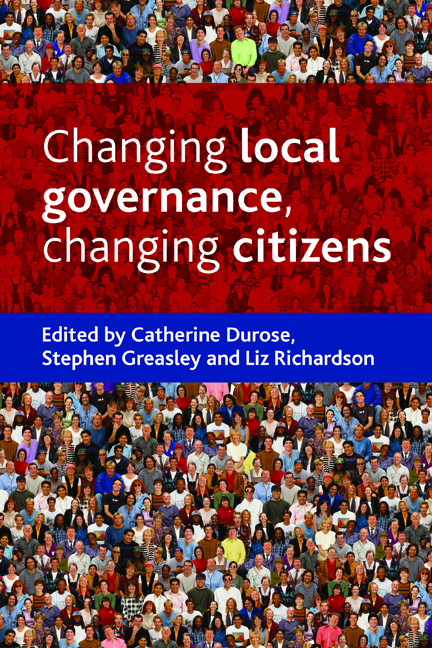Book contents
- Frontmatter
- Dedication
- Contents
- List of boxes and tables
- Acronyms
- Notes on contributors
- Acknowledgments
- Foreword
- Preface
- one Changing local governance, changing citizens: introduction
- two Citizen governance: where it came from, where it’s going
- three ‘Neighbourhood’: a site for policy action, governance … and empowerment?
- four Urban housing market restructuring and the recasting of neighbourhood governance and community
- five Citizen aspirations: women, ethnicity and housing
- six Can we promote cohesion through contact? Intergroup contact and the development of community cohesion
- seven New migrants, citizenship and local governance: ‘Poles’ apart?
- eight Citizens of faith in governance: opportunities, rationales and challenges
- nine Citizens’ reflections on behaviour change policies
- ten Every child’s voice matters?
- eleven e-citizenship: reconstructing the public online
- twelve Conclusion
- Index
three - ‘Neighbourhood’: a site for policy action, governance … and empowerment?
Published online by Cambridge University Press: 16 July 2022
- Frontmatter
- Dedication
- Contents
- List of boxes and tables
- Acronyms
- Notes on contributors
- Acknowledgments
- Foreword
- Preface
- one Changing local governance, changing citizens: introduction
- two Citizen governance: where it came from, where it’s going
- three ‘Neighbourhood’: a site for policy action, governance … and empowerment?
- four Urban housing market restructuring and the recasting of neighbourhood governance and community
- five Citizen aspirations: women, ethnicity and housing
- six Can we promote cohesion through contact? Intergroup contact and the development of community cohesion
- seven New migrants, citizenship and local governance: ‘Poles’ apart?
- eight Citizens of faith in governance: opportunities, rationales and challenges
- nine Citizens’ reflections on behaviour change policies
- ten Every child’s voice matters?
- eleven e-citizenship: reconstructing the public online
- twelve Conclusion
- Index
Summary
Introduction
‘Neighbourhood’ is a longstanding concept in public policy, with numerous initiatives and policy directives focusing on ‘neighbourhood’ being part of the policy agenda from the 1960s onwards. The ‘neighbourhood’ has re-emerged under New Labour as an organisational anchor for the promotion of planned change, a site for local governance and latterly as a site for encouraging more active citizenship. The concept of ‘neighbourhood’ has achieved significant normative appeal and resonance in public policy. The new governance and policy spaces created at the neighbourhood level, particularly under the reforms introduced by New Labour, offer unprecedented opportunities to reshape democracy, decision making and the delivery of services. This chapter examines to what extent those opportunities have been used, and used effectively.
Neighbourhoods are often the sites where the issues that matter most to people's lives are in sharpest relief. Neighbourhoods are areas where citizens identify with and feel a sense of belonging (CLG, 2007). However, there is no single generalisable definition of neighbourhood and ‘top-down’ administrative definitions often fail to capture the scale and nuance of citizens’ own understandings of their neighbourhoods.
This chapter uses Lowndes and Sullivan's (2008) typology of neighbourhood-based working under New Labour as a framework for exploring the different understandings of why neighbourhood working is happening, and how far this matches citizens’ needs and preferences. We find that there are several clear gaps between citizens and local government in how the neighbourhood agenda is being operated.
The chapter draws on extensive primary and applied research conducted by the authors over the last five years (Richardson, 2004, 2006; White et al, 2006; Durose, 2007; Durose and Lowndes, 2008; Richardson forthcoming).
What is neighbourhood-based working?
The rhetoric and policy drivers around neighbourhoods produced by central government are diverse and fluid and have led to an almost overwhelming array of neighbourhood-based initiatives. As Lowndes and Sullivan (2008: 6) comment: ‘neighbourhood based working is out there’. We use the term ‘neighbourhood-based working’ in this chapter as a generic term for a variety of forms of neighbourhood structures and processes. Two definitions of neighbourhood-based working are set out in Box 3.1.
Box 3.1: Definitions of neighbourhood-based working
A ‘neighbourhood approach’ is understood as a set of arrangements for collective decision making and/or public service delivery at the sub-local level.
- Type
- Chapter
- Information
- Changing Local Governance, Changing Citizens , pp. 31 - 52Publisher: Bristol University PressPrint publication year: 2009



